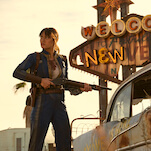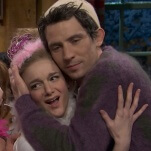Distilling 4 decades of Saturday Night Live down to just 10 episodes
With so many new series popping up on streaming services and DVD every day, it gets harder and harder to keep up with new shows, much less the all-time classics. With TV Club 10, we point you toward the 10 episodes that best represent a TV series, classic or modern. If you watch those 10, you’ll have a better idea of what that series was about, without having to watch the whole thing. These are not meant to be the 10 best episodes, but rather the 10 most representative episodes.
Saturday Night Live grew out of the dream of a legendary television entertainer who became a culture hero to his generation. That man’s name was Johnny Carson, and his dream was to take more vacation time from The Tonight Show. To this end, Carson sought to increase the value of his own reruns by instructing NBC that he was no longer good with affiliate stations being allowed to air them on weekend late nights. This development reignited the daydream some at the network had of colonizing that patch of broadcast real estate with original programming. That opened the door for two guys who formed an uneasy alliance based on their shared identification as members in good standing of the Baby Boomer generation: 30-year-old writer/comedian-turned-producer Lorne Michaels, and 28-year-old NBC executive Dick Ebersol. Though Michaels and Ebersol were still pretty young, they weren’t as young as they used to be, and they’d figured out that other members of what used to be called “the ’60s generation” might feel like spending part of a weekend evening sitting at home, watching the kind of entertainment they’d always had to seek out at concert venues and comedy clubs.
Allegations that SNL isn’t funny anymore, which go hand in hand with charges that it’s “lost its edge,” date back at least as far as 1979, when that cutting-edge journal of the electronic arts TV Guide ran an article called “Saturday Night Moribund.” (Yes, plays on the show’s name go back at least that far, too.) When really old people make these charges, they mean that SNL has lost the freshness and counterculture vibe it had in the mid-’70s. But it had that vibe because it was a necessary component to connecting with its target audience then. As the show became more successful, it became bigger, less intimate, and splashier, but it has also changed to fit the times. At some point it turned into an institution, and institutions are conservative by nature. That doesn’t mean the show’s politics became conservative, though that’s sometimes been the upshot of its efforts to embody, and never challenge, the zeitgeist. (The story that Lyndon Johnson looked up from the evening news and announced that he knew he’d lost Middle America on the Vietnam War because he’d lost Walter Cronkite is apocryphal, but it’s true that people in the first Bush White House breathed a sigh of relief when they watched Saturday Night Live during the 1991 Gulf War and saw that, rather than satirizing the rationale behind the war, the show was doing sketches harshly ridiculing dumb ol’ reporters who thought they had any business asking questions about it.)
The show has only had three producers in all its years on the air: Michaels, who ran it from 1975 until 1980, returning in 1985 after having failed to make lightning strike twice with the ambitious prime-time The New Show; Jean Doumanian, who was responsible for the justly infamous 1980-81 season; and Ebersol, who held the reins until Michaels wanted them back. Michaels, a deft self-promoter who started making self-mythologizing cameo appearances early in the show’s history, usually gets the credit for shaping and guiding SNL, but Ebersol, who often gets treated in show histories as a humorless interloper, may have better understood the nature of the beast. After Doumanian, who had a vague notion that the show needed to remain relevant by embracing a “New Wave” spirit, had devalued the brand, Ebersol built it back into a hit by making the trains run on time and emphasizing whatever elements seemed most popular with the audience. When Michaels came back, he tried to inject some wild daring back into the show—for instance, assigning Terry Sweeney, the show’s first openly gay cast member, the job of official Nancy Reagan impersonator. When this version met with mixed reaction from audiences and critics, Michaels retooled, and the version he settled on—and is still grinding out to this day—looks a lot like a shinier version of Ebersol’s show.
Although SNL has been used by people who had an agenda, the show itself has no agenda beyond being funny, timely, and popular. Its great value is in offering talented new people a chance to show a national television audience what they can do within those guidelines. Some of them go on to great things; some of them latch onto one catchphrase or supremely irritating character and try to milk it all the way to their graves. Damned if some of them don’t seem intent on doing both. (“Every great band should be shot,” Too Much Joy once opined, “before they make their Combat Rock.” Somebody should write a song like that about Kristen Wiig and Gilly.) Keep in mind that what follows, in accordance with TV Club 10 tradition, is an attempt to suggest, in 10 episodes, the broadest, least sucky outline of the show’s accomplishments, not a “10 best” list. We could spend the rest of the year just arguing over what a “best” episode of Saturday Night Live might look like.
“Richard Pryor” (season one, episode seven): Guest stars were much more important to SNL in its first years than they would ever be again. Rock-star comedians such as George Carlin (who hosted the first show), Lily Tomlin, and Robert Klein were used to give the show credibility and signal to wary, TV-hating audiences that this might be a show worth checking out. As the hippest comic and funniest man alive at the time, Pryor was an especially essential “get,” and Michaels made accommodations for him that he probably wouldn’t make for anyone today, agreeing to let him bring in his own writers, pick the musical guest (Gil Scott-Heron), and allow one of his ex-wives, Shelley, to deliver a whimsical beat-poetry fable about forbidden love between a mismatched pair of merry-go-round horses. For his reward, Michaels wound up with an essential 90 minutes (including commercials) of television, and the purest distillation of Richard Pryor, the greatest stand-up comic who ever lived, that ever appeared on the box.
“Steve Martin” (season three, episode 18): Martin was still a largely unknown stand-up comic when he first hosted the show in the fall of 1976. He became the first outsider to take on the stature of an honorary cast member; this was the fifth show he hosted in 18 months. (Buck Henry, another regular face whose hosting the season finale became a tradition, was more of a senior figure/mascot, beloved for his easygoing style and happy willingness to do material that had been cut from previous shows.) This Emmy-nominated episode has acquired a reputation as the best of all Martin’s hosting gigs; that’s debatable, but it does epitomize the point when SNL moved from cult hit to cultural steamroller. It certainly sums up the unlikely moment when the show even took command of the pop charts: The musical guests are the Blues Brothers, and Martin stars in a production number that serves to introduce his novelty song “King Tut.”














![HBO teases new Euphoria, Larry David, and much more in 2026 sizzle reel [Updated]](https://img.pastemagazine.com/wp-content/avuploads/2025/12/12100344/MixCollage-12-Dec-2025-09-56-AM-9137.jpg)

























